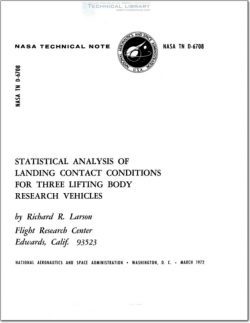NASA-TN-D-6708

- Version
- 171 Downloads
- 2.13 MB File Size
- 1 File Count
- June 16, 2016 Create Date
- June 16, 2016 Last Updated
Statistical Analysis of Landing Contact Conditions for Three Lifting Body Research

Statistical studies (for example, refs. 1 to 4) of landing conditions for various types
of aircraft have been used by designers to compare predicted with actual landing condi—
tions and, therefore, more accurately determine the landing load requirements for the
aircraft studied and similar aircraft. The studies have also aided in designing future
aircraft and in improving the overall safety of flight operations.
A new type of aircraft—Wingless, lifting bodies—was developed recently for which
no landing study had been made. The use of these vehicles as piloted reentry aircraft
is being studied. One important advantage offered by this type of vehicle would be the
capability of landing at a predetermined landing strip, which would eliminate the need
for a costly ocean recovery operation and permit reuse of the vehicle. Three lifting
body configurations have been tested by the NASA Flight Research Center— the HL—10,
M2—F3, and the X—24A. Sufficient touchdown data were obtained for a statistical
analysis to be made. Results of the analysis are presented in this report. The landing
contact parameters examined were true airspeed, peak normal acceleration at the
center of gravity, roll angle, and roll velocity. The ground measurement parameters
examined were lateral and longitudinal distance from the intended touchdown point,
lateral distance from touchdown to full stop, and rollout distance. Vertical velocity
at touchdown is not presented in this report because instrumentation was not pro—
vided.
Physical quantities in this report are given in the International System of Units (SI)
and parenthetically in U. S. Customary Units. Measurements and calculations were
made in Customary Units. Factors relating the two systems are presented in refer—
ence 5.
The three lifting body vehicles (fig. 1) are generally similar in planform shape and
have blunt noses, thick stabilizing control surfaces, and thick, squared—off bases.
Sixteen M2—F2 flights were made before a center fin was installed to improve the
handling qualities. The vehicle was then redesignated the M2-F3.
| File | Action |
|---|---|
| NASA-TN-D-6708 Statistical Analysis of Landing Contact Conditions for Three Lifting Body Research.pdf | Download |

Comment On This Post